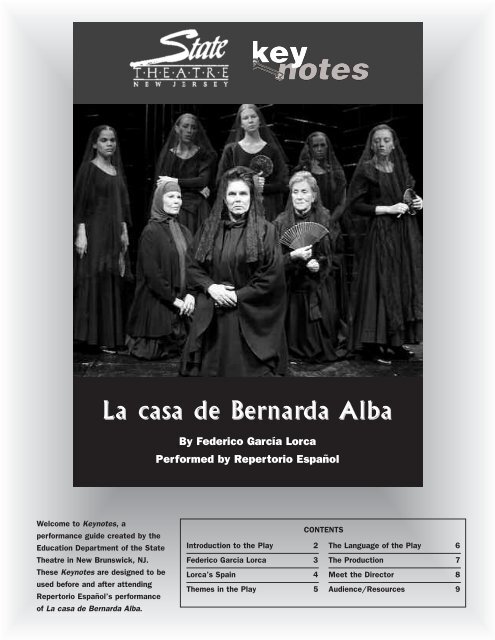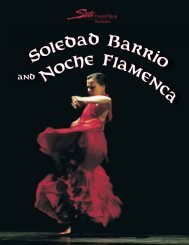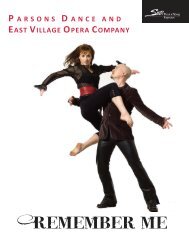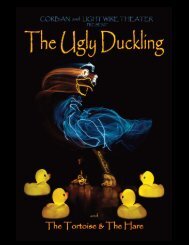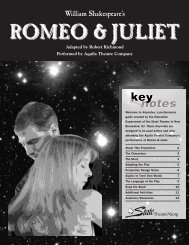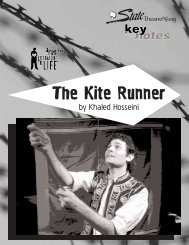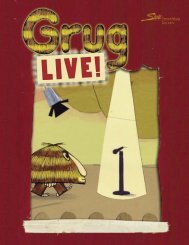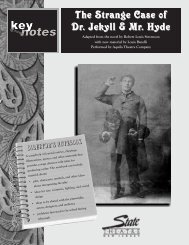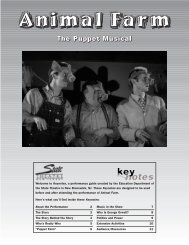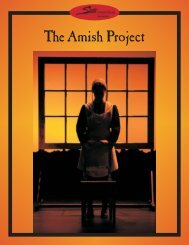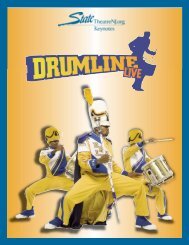Bernarda Alba.qxd - State Theatre
Bernarda Alba.qxd - State Theatre
Bernarda Alba.qxd - State Theatre
- No tags were found...
Create successful ePaper yourself
Turn your PDF publications into a flip-book with our unique Google optimized e-Paper software.
La casa de Bernarnarda<strong>Alba</strong>By Federico García LorcaPerformed by Repertorio EspañolWelcome to Keynotes, aperformance guide created by theEducation Department of the <strong>State</strong><strong>Theatre</strong> in New Brunswick, NJ.These Keynotes are designed to beused before and after attendingRepertorio Español’s performanceof La casa de <strong>Bernarda</strong> <strong>Alba</strong>.CONTENTSIntroduction to the Play 2 The Language of the Play 6Federico García Lorca 3 The Production 7Lorca’s Spain 4 Meet the Director 8Themes in the Play 5 Audience/Resources 9
Introduction to the Play 2Welcome to the performance of Federico GarcíaLorca’s La casa de <strong>Bernarda</strong> <strong>Alba</strong>. Before your visit tothe <strong>State</strong> <strong>Theatre</strong>, we hope you’ll use these Keynotes tobecome familiar with the play and your role as a memberof the audience. You’ll also find questions and activitiesto do in class.The play will be performed by Repertorio Español in itsoriginal language, Spanish. If you don’t understandSpanish, during the show you can listen to an Englishtranslation through a special headset.Enjoy the show!La Poncia and <strong>Bernarda</strong>The StoryThe play takes place in a small village in southern Spain following the funeral of<strong>Bernarda</strong> <strong>Alba</strong>’s second husband. <strong>Bernarda</strong> announces to her five daughters thattheir family will observe a period of mourning lasting eight years. During this time,she says, they must remain inside the darkened house doing needlework. Themaidservant, La Poncia, says it is time for the girls to have husbands, but <strong>Bernarda</strong>insists there are no men worthy of them. She sternly declares to her daughters thatshe will rule in her own house as long as she lives.Each of <strong>Bernarda</strong>’s daughters harbors a secret passion for Pepe el Romano, themost handsome man in the village. Pepe is engaged to Angustias, <strong>Bernarda</strong>’s eldestdaughter. At 39, she is 14 years older than her fiancé, but Pepe is not marrying herfor love; as the eldest, Angustias will inherit her father’s money and land. (Despitethe engagement, <strong>Bernarda</strong>’s youngest daughter, Adela, has secretly become Pepe’slover.) We also meet María Josefa, the senile old grandmother,SPINSTER - anwho says she wants to get away from all these spinsters andolder, unmarriedmarry a beautiful man from the sea.womanOne day, as the women sit at their sewing, Angustias burstsin to accuse one of her sisters of stealing her picture of Pepe. The culprit is finallyidentified: the gloomy and sickly Martirio. Later, a commotion erupts outside thehouse; an unmarried girl who has just killed her newborn baby is being draggedthrough the town by a mob. To Adela’s horror, <strong>Bernarda</strong> screams, “Kill her!”Eventually, <strong>Bernarda</strong> learns the truth about Adela and Pepe. Furious, she grabs agun and rushes out to shoot the young man. Martirio announces that Pepe has beenkilled, though she knows <strong>Bernarda</strong>’s shot has missed. Her lie hits its mark, however;believing Pepe is dead, Adela runs out and kills herself. <strong>Bernarda</strong>’s greatest concernis for her family’s honor—the public must never know that Adela gave up hervirginity without being married. To her weeping daughters, she cries out, “Silence!”The CharactersBERNARDA ALBA - thematriarch of the householdLA PONCIA - <strong>Bernarda</strong>’s maidand confidanteANGUSTIAS - <strong>Bernarda</strong>’seldest daughter, age 39;engaged to marry Pepe elRomanoMAGDALENA - <strong>Bernarda</strong>’sdaughter, age 30AMELIA - <strong>Bernarda</strong>’s daughter,age 27MARTIRIO - <strong>Bernarda</strong>’sdaughter, age 24; the “sicklyone”ADELA - <strong>Bernarda</strong>’s youngestdaughter, age 20; having anaffair with Pepe el RomanoMARIA JOSEFA - <strong>Bernarda</strong>’smotherCRIADA - <strong>Bernarda</strong>’s servantPRUDENCIA - <strong>Bernarda</strong>’s friendNIÑA - a young girl
Federico García Lorca 3Federico García Lorca was born in Fuente Vaqueros, a small farmingtown outside of Granada, Spain. When he was 11,JESUIT - a RomanLorca moved with his family to the city and attendedCatholic religiousa Jesuit school. He later enrolled in the Universitygroupof Granada, where he concentrated on writing poetry,painting, playing the piano, and reading great literature from Spain, LatinAmerica, and France, Shakespeare, and Spanish and Greek drama.In 1919, Lorca moved to Madrid, where he met influential Spanishartists including the painter Salvador Dalí and film director Luis Buñuel.He staged his first major play, which closed after just four performances.Despite this failure, Lorca persisted, and in 1927 his play, Mariana Pineda,with stage settings by Dalí, opened to much acclaim in Madrid. During the1920s, Lorca’s greatest success was as a poet. He published Libro depoemas (Book of Poems) in 1921, his celebrated Canciones (Songs) in 1927,and Primer romancero gitano (Gypsy Ballads) in 1928.Though at the height of his fame, Lorca suffered increasingly fromdepression, which was made worse by having to conceal his homosexualityfrom friends and family. Hoping a change of surroundings would improvehis outlook, he traveled abroad. He spent a good deal of time in New York,a city he found “Babylonic, cruel, and violent” but also “filled with a greatmodern beauty.” His trip resulted in a book of poetry entitled The Poet inNew York.Lorca returned to Spain in 1930 and was appointed director of agovernment-sponsored student theater company that toured Spain,introducing rural audiences to classic Spanish theater. At this time, hewrote his best-known plays, the ‘rural trilogy’ of Bodas de sangre (BloodWedding), Yerma, and La casa de <strong>Bernarda</strong> <strong>Alba</strong> (The House of <strong>Bernarda</strong><strong>Alba</strong>). Lorca completed La casa de <strong>Bernarda</strong> <strong>Alba</strong> in the last year of his lifebut never had a chance to see it performed.In July 1936, at a time of tremendous political unrest, Lorca ignored hisfriends’ warnings and left Madrid for Granada. Two days later, civil warbroke out in Spain between the Spanish Republic and nationalist rebels(Fascists) led by General Francisco Franco. Lorca’s brother-in-law, themayor of Granada, was arrested and then executed by Franco’s forces. OnAugust 16, Lorca himself was arrested and then put to death. To thisday, the reason for his execution still remains a mystery; as a publiccelebrity whose family sided with the republican cause, he mayhave been considered a threat by the Fascists. After hisexecution, Lorca was buried in an unmarked grave in a grove ofolive trees. In an effort to erase the author’s existence, much ofhis work was banned and, until recently, was not published orproduced.Federico García LorcaLa casa de la poesíaLorca is equally celebrated as aplaywright and a poet. While his playsare not literally poems, they oftenmake use of poetic language.Try creating your own poem, in Englishor in Spanish, in the voice of one ofthe characters from La casa de<strong>Bernarda</strong> <strong>Alba</strong>. What subject wouldyour character be most likely to writeabout? What would she have to say?Once your poem is completed, gettogether with your classmates tostage a <strong>Bernarda</strong> <strong>Alba</strong> poetry reading.See if the audience can figure outwhich character from the play isspeaking in each poem.Because the Fascistregime in Spain worked so hard tosuppress Lorca’s work, La casa de<strong>Bernarda</strong> <strong>Alba</strong> was not published orperformed until almost a decade after itwas written. The play was finally producedand published in Argentina in 1945.It was not produced in Spainuntil 1964.
Lorca’s Spain 4Andalucia: Land of LorcaCórdobaLorca grew up in Granada, which is located in a region insouthern Spain known as Andalucia. This region includes the HuelvaSevillaprovinces of Almería, Cádiz, Córdoba, Granada, Huelva, Jaén,Málaga, and Sevilla. The capital is the city of Seville.MálagaAndalucia has a varied climate: subtropical on the MediterraneanJaénGranadaAlmeríacoast, temperate on the Atlantic coast, and cooler in the highlands, where Cádizsnow is not unusual. The warm climate of the valleys and plains is ideal forThe Andalucian region of Spaingrowing oranges, olives, sugarcane, wheat, corn, and other grains. The history ofAndalucia is an eventful one; since the distant past, it has been settled or conquered by many different civilizations fromAfrica and the Middle East to northern Europe. Each of these groups has left a lasting impression on the culture of the region.The Political and Social ClimateDuring Lorca’s adulthood, Spain was locked in a chaotic powerstruggle. On one side were the Loyalists (also known as Republicans),Spaniards loyal to the elected democratic government. The Loyalistside was generally liberal to moderate; theirSECULAR - notpower base was urban and secular and wasconnected toparticularly strong in industrial regions likereligionAsturias and Catalonia. On the other side werethe rebel Fascists (also known as Nationalists). This largelyconservative group favored the centralization of power in a singleauthority. Their base of support was primarily rural, wealthy,conservative, and Roman Catholic. The Fascists appealed to people’ssense of national identity, rallying followers in mass parades andencouraging suspicion and hatred of foreigners.The clash of political beliefs erupted into the Spanish Civil War, thebloodiest conflict in the first half of the 20th century. It lasted from July17, 1936 until March 28, 1939. The Fascists emerged victorious, andtheir leader, the dictator General Francisco Franco, remained Spain’shead of state until his death in 1975.In addition to the political chaos, a number of social issues stronglyaffected the lives of the common people in 1930s Spain. Conditions forwomen were extremely oppressive. Single women were not allowedoutside without chaperones, and without their consent they could be“given away” in arranged marriages. Female agricultural workersworking the same hours as men were paid half as much in wages andstill had to go home at the end of the workday tocook and clean. Lorca recognized the struggles of PROTAGONIST -his countrywomen and for this reason used themthe maincharacter in a playas the protagonists in many of his plays.Generation of ‘27Federico García Lorca was a member of theGeneration of ‘27, an influential group ofpoets that arose in Spain between 1923 and1927. This group formed outof a shared desire toexperience and workwith avant-gardeforms of art andpoetry. TheGeneration of ‘27writers embraced a wideAVANT-GARDE -radically new ordifferent; cuttingedgevariety of genres, styles, and viewpoints.Members of the group included García Lorca,Rafael Alberti, Vicente Aleixandre, DámasoAlonso, Manuel Altolaguirre, Luis Cernuda,Gerardo Diego, Jorge Guillén, Emilio Prados,and Pedro Salinas.Though the Civil War did not end themovement, Lorca was murdered and othermembers were forced into exile. All of thesurviving Generation of ‘27 members keptwriting and publishing late into the 20thcentury.Research some of the writers who were partof the Generation of ‘27. How does theirwork differ from Lorca’s? What commontraits brought them together? What socialissues had the biggest impact on theirwriting?
Themes in the Play 5Women’s LivesLike Lorca’s other major plays, La casa de <strong>Bernarda</strong> <strong>Alba</strong>features women as the central characters. (During the play, menare mentioned, but never actually seen.) The story is set inspaces traditionally associated with women, such as the homeand kitchen. The characters constantly make reference to theirplace as women in a society that has very strict social codesgoverning the behavior of both sexes.<strong>Bernarda</strong> takes these rules to an extreme, prohibiting all butone of her daughters from having any contact with men. Indenying them an outlet for their sexual needs and desires, shebrings about the tragedy that ends the play.Prudencia visits <strong>Bernarda</strong> <strong>Alba</strong> and her daughters.Based on the following lines from the play, what can you inferabout the characters’ attitudes about gender? What do you think itwould be like to be to be a young woman living in <strong>Bernarda</strong> and Poncia’s household?BERNARDA: “Needle and thread for women. Whiplash and mules for men.”PONCIA:“They’re women without men, that’s all; and in such matters even blood is forgotten.”DeathDeath hovers over the characters in La casa de <strong>Bernarda</strong> <strong>Alba</strong> throughout theentire story. The play opens on the day of her husband’s funeral, when <strong>Bernarda</strong>imposes an eight-year mourning period on her household. All the daughters exceptAngustias face eight years of being trapped inside their house with nobody to talk toexcept for each other and little contact with the outside world.Given what you know about Lorca, why do you think he would choose to focus onthe theme of death? Does the situation in which <strong>Bernarda</strong>’s daughters findthemselves reflect anything in his own experience?As you watch the performance, notice the ways that death affects the women inthe play. Do they all have the same reaction? What lines in particular give youinsight into their responses to death?Adela and MartirioReason and PassionSome of the characters in this play respond to situations with reason (commonsense), while others are guided by passion (emotions).Which characters in the play are guided by reason, and which by passion? (Citespecific words or actions to support your opinions.) Which characters have themost influence—the sensible ones or the emotional ones?MartirioDo you think it’s wise to make choices in life based solely on reason or passion?Why or why not? What are some of the consequences of doing so?
The Language of the Play 6Lorca’s work has been described as poetry brought to lifeon the stage. Much like his poetry, Lorca’s plays use languagethat is both rhythmic and layered with meaning.Read the excerpt below from La Casa de <strong>Bernarda</strong> <strong>Alba</strong>. Whatdo you notice about the language? Are there any qualitiesthat make it sound similar to poetry? Does the rhythm of thetext change when translated into English?MartirioEs preferible no ver a un hombre nunca. Desde niña lestuve miedo. Los veía en el corral uncir los bueyes ylevanter los costales de trigo entro voces y zapatazos ysiempre tuve miedo de crecer por temor de encontrarmede pronto abrazada por ellos. Dios me ha hecho débil y feay los ha apartado definitivamente de mí.Amelia¡Eso no digas! Enrique Humanas estuvo detrás de ti y legustabas.Martirio¡Invenciones de la gente! Una vez estuve en camisa detrásde la ventana hasta que fue de día, porque me avisó conla hija de su gañán que iba — venir y no vino. Fue cosa delenguas. Luego se casó con otra que tenía más que yo.MartirioIt’s better to never lay eyes on a man. Since I was a child,I’ve been afraid of them. I used to see them in the corral,harnessing the oxen and loading the sacks of wheat, withloud voices and clumsy feet, and I was always afraid ofgrowing up, for fear of suddenly finding myself in theirclutches. God made me weak and ugly and set themapart from me forever.AmeliaDon’t say that! Enrique Humanas was after you and heused to like you.MartirioThe things people make up! Once I stood at the window inmy nightgown until daylight because his field hand’sdaughter told me he was going to come by, and he didn’t.It was all just talk. Then he married someone with moremoney than me.¡Y fea como un demonio!AmeliaAnd as ugly as the devil!Ameliaits“Atheatrebranches,changethat is sensitive and well-orientedfrom tragedytothe sensibility of the people...”invaudeville, can in-Federico Garcíaalla fewLorcayearsUsing either the Spanish or English text above, workwith a partner to explore the range of expression youcan achieve by speaking the lines aloud in differentways. Try varying the volume, speed, and pitch (high orlow) of your voice, and where you put the pauses. Whathappens if you emphasize certain words? Alsoexperiment with gestures, body language, and facialexpression.At the performance, listen for these lines and noticehow the actors interpret them. Did they perform themthey way you expected? What is the difference betweenreading Lorca’s lines and seeing them acted out?
The Production 7Repertorio Español’s production design for La casa de <strong>Bernarda</strong> <strong>Alba</strong>is very simple. The stage is practically bare andABSTRACT - tothe colors dark. When staging this piece, directorlook at somethingRené Buch wanted a design that would not lockwithout referencethe story into a specific time and place norto a specificovershadow the performers and the words. Heenvironmentsays, “We simplify and abstract the play in orderto emphasize symbols and to focus the attention exclusively on what issaid or done by the actor.”While you’re watching the performance, keep an eye out for theseelements of the production design:The SetsThe backdrop, which resembles a set of ladders, is created with metalbars hung from chains in different directions across the back of the stage.Actors enter and exit through these “ladders” and as they do, the metalbars hit together to create an array of sounds. There are just a few setpieces, such as small black boxes that the actors use at the beginning ofAct III to suggest sitting around a dinner table.During the show, pay attention to how the actors and the script createa sense of the surroundings without using lots of set pieces.What do you think is the significance of the sounds created by themetal bars hitting together?The Costumes and PropsCostumes and props are often used to help establish time period andlocation, and to indicate the age and social position of the characters. Inthis production, however, the design team created costumes that arevery plain and not specific to a particular time and place. The sisterswear black leotards with long black skirts. Props are minimal, too, andinclude rags for the maids and sheets for the daughters to stitch and fold.What does the costume design say about the social position of thecharacters?The LightingLighting helps convey mood, atmosphere, and time, and helps theaudience focus on a particular image. The timing, color, and placement ofthe lighting are carefully coordinated with the actors and scenes.During the show, look for interesting patterns created by the lightingdesign. Did the lighting help draw your attention to any particularcharacters or locations?Pay particular attention to the way the lighting design helps make adistinction between the indoor and outdoor scenes.Maria JosefaWhat Would You Do?Lorca never had the chance to see Lacasa de <strong>Bernarda</strong> <strong>Alba</strong> performed, but heleft detailed directions in the script for howthe sets should look. Here’s hisdescription of the setting for Act I:A very white room in <strong>Bernarda</strong>’s house.Arched doorways with jute curtainstrimmed with silk tassels and ruffles.Wicker chairs. Pictures of nymphs orlegendary kings in improbablelandscapes. It is summer.Why would the director and designerschoose a design for their production that iscompletely different from what the authorindicated? Do you think artists shouldstick to what the author wrote, or is it okayfor them to change things to express theirown ideas about the play?What choices would you make if youwere staging a production of La casa de<strong>Bernarda</strong> <strong>Alba</strong>? What would your sets,costumes, and lighting look like? Thinkabout setting the play during Lorca’s timeversus setting it today; how does thetime period dictate your choices? Createa director’s notebook with sketches ofyour sets and costumes and notes onsound and lighting for your production.
Meet the Director 8René Buch, the Artistic Director of Repertorio Español since its inception, has hada lot of experience directing the plays of Lorca. He has directed multiple productionsof Bodas de sangre, La casa de <strong>Bernarda</strong> <strong>Alba</strong>, Yerma, Don Perlimplín, Doña Rosita lasoltera (Doña Rosita the Old Maid), and El público (The Audience). In this interview, hereflects on his most recent production of <strong>Bernarda</strong> <strong>Alba</strong>.Q: How would you describe the changes in your approach toLorca’s plays over four decades of directing them?A: What I’ve been trying to do is to refine my approach. Lorcasaid once that a play was like a poem standing up. Whatwe’re trying to do in all our productions is to put the poetryon its feet, so that people can respond to what he said.Q: Have your ideas about Lorca’s characters changed muchover the years?A: I think that I have refined them, more than anything. Thecharacters are mythical. They’re always the same, and theydon’t change... Everything is imbued with sexuality and death.Q: Your theme of the repressed instinctual life and itsrevenge—does that recur in Lorca’s other tragedies?A: Yes. It’s the point in <strong>Bernarda</strong><strong>Alba</strong>, where Adela accepts herfate. She wants her sexual lifefulfilled, and the tragedy in thiscase is that she does it. But<strong>Bernarda</strong> is the tragic figurebecause she has doneeverything, and everything thatshe’s done is wrong. At the end,I think she’s destroyed by thedeath of Adela.Q: In this production, is thefiercely dominating mother stillthe tragic heroine?Adela suffers becauseher mother does notallow her to expressher natural sexuality.But <strong>Bernarda</strong> believesshe is doing what isbest for her family byputting respectability(virginity) aboveindividual needs anddesires. Working with aclassmate, role-play adebate between AdelaA: I haven’t changed my point of and <strong>Bernarda</strong> aboutview. She’s like a communist whose way is right.who believes in the communistparty, and by following instructions she’s destroyed her family.When she comes to cry “Silencio” at the end of the play,she’s aware of her tragedy and her destruction. I don’t like<strong>Bernarda</strong> to be a monster all the time. I see her as a victim.They’re all victims of the society... The people who don’t givein to sexuality.La Poncia and the sisters at their sewingQ: What about the progress of your imagery in producing<strong>Bernarda</strong> <strong>Alba</strong>?A: The first time we did <strong>Bernarda</strong>, we had enormously thickstyrofoam walls and a roof of styrofoam, with holes for doors.People would come through the doors as if they were ratscoming from holes. But for the second one we just used awall of black mesh that made a corner.Q: Is this <strong>Bernarda</strong> <strong>Alba</strong> another “black” production... anotherstark and spare production that highlights the poetry?A: It sure is. The scene is a labyrinth of things hanging—allblack. It’s like walls made of hanging things-ladders, etc.—and it covers the whole stage. Later, when the daughters aresewing, the material the girls sew covers the whole stage,too. There’s no sitting down except in the third act, when theyare supposed to be eating, butRené Buch makes athey’re not eating, they’re sittingon black cubes. It’s far moreconnection betweenabstract; it’s less Spanish. the theme of this playQ: Do you mean the charactersand themes seem moreuniversal?A: Yes. The [religious right] inthis country has given me a hintthat this could take placeanywhere.and religiousfundamentalism. Doyou think La casa de<strong>Bernarda</strong> <strong>Alba</strong> couldbe set in an orthodoxJewish, Muslim,evangelical, or otherfundamentalistsociety? Why?
Audience/Resources 9Do You Know Your Part?As a member of the audience, you are a crucial part of theperformance. Before you arrive at the theater, make sure youknow your role!• When you enter the theater, follow an usher to your seat.• Once the house lights (the lights in the part of the theaterwhere the audience is sitting) go down, focus all yourattention on the stage.• Attending a live theater performance is not the same aswatching television at home. At the theater, talking, eating,or moving around disturbs the performers and othermembers of the audience. So watch and listen carefully tothe performance. And please no food or beverages!• Don’t bring cameras, camcorders, tape recorders, or anyother recording equipment to the performance. You willnot be allowed to use them.• If something in the play is funny, go ahead and laugh. Andof course, please applaud at the end of the performance ifyou liked what you saw!• After the performers are finished taking their bows, stay inyour seat until your group gets the signal to leave thetheater.ResourcesBOOKS:The House of <strong>Bernarda</strong> <strong>Alba</strong>, by Federico García Lorca.Methuen Student Edition, 2004Federico García Lorca: A Life, by Ian Gibson. Faber &Faber, 1990Fire, Blood and the Alphabet: One Hundred Years ofLorca, by Sebastian Doggart & Michael Thompson(eds.). University of Durham, 1999El Asesinato De Garcia Lorca, by Ian Gibson. Plaza &Janes Editores, S.A., 1998 (in Spanish)The Spanish Civil War, by Anthony Beevor. Penguin,2001WEBSITES:Keynotes are produced by the Education Department of the <strong>State</strong> <strong>Theatre</strong>,New Brunswick, NJ.Wesley Brustad, PresidentLian Farrer, Vice President for EducationKeynotes written and designed by Lisa Beth VettosoEdited by Lian Farrer© 2006 <strong>State</strong> <strong>Theatre</strong>The <strong>State</strong> <strong>Theatre</strong>’s education program is funded in part by Bristol-Myers Squibb, Brother InternationalCorporation, James and Diane Burke, the E & G Foundation, Johnson & Johnson, the J. Seward JohnsonFoundation, the Robert Wood Johnson Foundation, the Karma Foundation, the John F. Kennedy Center forthe Performing Arts, the Blanche and Irving Laurie Foundation, the McCrane Foundation, the NationalStarch and Chemical Foundation, the PNC Foundation, and the Wachovia Foundation. Their support isgratefully acknowledged.Funding has been made possible inpart by the New Jersey <strong>State</strong> Council onthe Arts/ Department of <strong>State</strong>, apartner agency of the NationalEndowment for the Arts.Continental Airlines is the officialairline of the <strong>State</strong> <strong>Theatre</strong>.Repertorio Españolwww.repertorio.orgOverview of Lorca with pictures and a poetry samplewww.cyberspain.com/passion/lorca.htmBiography of Lorca’s life with a list of his workswww.wikipedia.org/wiki/Federico_Garc%C3%ADa_Lorca<strong>State</strong> <strong>Theatre</strong>www.<strong>State</strong><strong>Theatre</strong>NJ.orgVIDEO:La casa de <strong>Bernarda</strong> <strong>Alba</strong> (1987), directed by MarioCamus. Available on amazon.com


